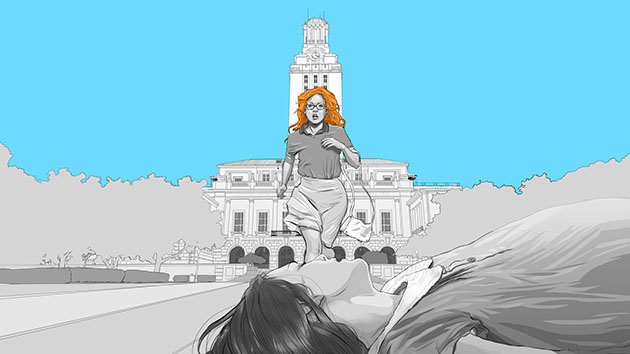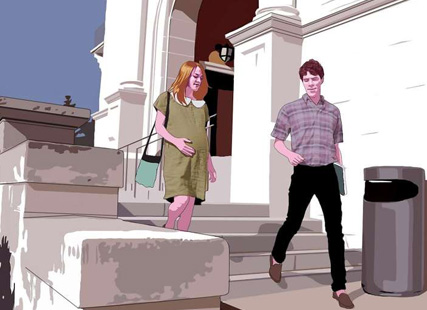Today@Sam Article
SHSU To Screen 1966 Texas Tragedy Documentary
March 22, 2017
SHSU Media Contact: Teddi Cliett

Story by Teddi Cliett
On Aug. 1, 1966, students and faculty on the University of Texas campus thought they heard leftover Fourth of July fireworks exploding into the hot southern sky. It wasn’t until bodies started dropping to the pavement that the campus realized they were under attack by a mystery shooter, hiding away on the top floor of the clock tower. It was the first school shooting in national history.
Fifty years later, the animated documentary “Tower” retells the tainted Texas story by combining archival footage with rotoscopic animation for a unique viewer experience.
Now, Sam Houston State University students and the Huntsville community will be able to witness how the worst in one man brought out the best in so many others, in a free screening of “Tower,” on March 30 at 7:30 p.m. in the James and Nancy Gaertner Performing Arts Center Dance Theatre. Admission to the screening is free.
The event is hosted by the Department of Art’s animation program and organized by SHSU art professor Edward Morin, who said he wanted to bring a screening of the film to campus to give Texans a chance to revisit history.
“Ultimately, it was the historic significance of the story that I was interested in,” Morin said. “I grew up in Texas and knew about the shooting, but I do not remember learning about the details of it in school. I imagine there are a lot of people that have grown up in the state who do not know much about it either. I hope that bringing the film here will fill that gap.”
The documentary has received national attention not only for its powerful storytelling, but for its use of animation as well.
During the first half of the film, the people who are retelling their memories of the shooting are portrayed as animated characters and are represented at the age they were when the attack occurred.
“The use of rotoscoping serves to portray the actors filling in this role with a sort of realism, but it leans more toward abstraction,” Morin said. “I think that this abstracted representation makes the idea that we are being transported to that past more believable.”
SHSU mass communication professor Christopher White attended the UT graduate program in the 1980s and noted that the use of animation added to the intensity of some already powerful scenes.
As a former Longhorn, White said the documentary accurately matched up with the stories he had already heard and even reminded him of a few things, like the number of people who were shot and the amount of time it took for the violence to stop.
After 96 minutes of confusion and terror, 17 people were pronounced dead and 31 suffered injuries of some sort. Although plenty of time had passed between when the shooting occurred and when White attended the university, the tower was, in some ways, still stained.
“I do remember occasionally just walking through the mall area and looking up at that tower and envisioning the horror of that day,” White said.
Unlike now, where mass shootings occupy the news space for days on end, there was much less acknowledgement of the tragedy in 1966.
"It really was pushed aside,” said “Tower” director Keith Maitland in an interview with NPR. “People were encouraged to move forward and not linger in the terrible tragedy of that day. Looking back, I think that was a mistake, and I think that cost people, people who were there that day, people who were traumatized by the event, it cost them an opportunity to deal with that trauma."
That’s part of the reason why Maitland wanted to make the film, and why he did it in such a unique way.
Although animation has a tendency to be associated with children or comedy, Morin said this screening is an opportunity for viewers to witness how effective animation can be in storytelling.
“I would like students to think about the importance of image, composition and editing in visual storytelling, and how animation and film can connect us to a deeper human experience.”
Whether it be intentional or not, “Tower” can’t help but make viewers think about other mass shootings that have happened since, like the Columbine or Sandy Hook tragedies that wrapped the nation in sorrow. Morin hopes those thoughts will encourage audience members to take a closer look at American society.
“It certainly provides an opportunity to reflect on the issue of guns and violence in our culture,” Morin said. “Regardless of what one may feel about this issue, “Tower” makes us think about the humanity of what happened and how people were affected, not just on that day, but for the rest of their lives. It forces us to listen, I think we need to spend more time doing that.”
- END -
This page maintained by SHSU's Communications Office:
Director of Content Communications: Emily Binetti
Communications Manager: Mikah Boyd
Telephone: 936.294.1837
Communications Specialist: Campbell Atkins
Telephone: 936.294.2638
Please send comments, corrections, news tips to Today@Sam.edu
